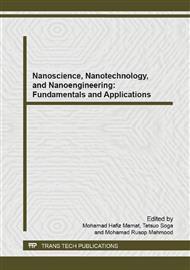p.186
p.191
p.195
p.200
p.205
p.210
p.214
p.219
p.223
Epoxidised Natural Rubber/Silica Organic-Inorganic Composite for Tyre Masterbatch
Abstract:
Epoxidized natural rubber (ENR) / silica (Si) organic-inorganic composites were prepared by using a sol-gel technique. The choice of ENR (50 mol % epoxidation level), as a matrix was made because of its polar nature which can interact with the silica. The processing of the masterbatch was carried out by sol-gel method at room temperature by dispersing the silica in the rubber and coagulated with steam bath. The performance of the composites was evaluated in this work for the viability of ENR/Si in tyre compounding. Compounding was carried out on a two roll mill, where the additives and curing agents was later mixed. Characterization of these composites was performed by Field Emission Scanning Electron Microscopy (FESEM) and Transmission Electron Microscopy (TEM) for dispersion as well as mechanical testing. Silica was also efficient as primary reinforcing filler in ENR with regard to modulus and tensile strength, resulting on an increase in the stiffness of the rubbers. Improvement in tensile strength over the control crosslinked rubber sample was probably due to synergisms of silica reinforcement and crosslinking of the rubber phase.
Info:
Periodical:
Pages:
205-209
Citation:
Online since:
June 2015
Authors:
Keywords:
Price:
Сopyright:
© 2015 Trans Tech Publications Ltd. All Rights Reserved
Share:
Citation:


